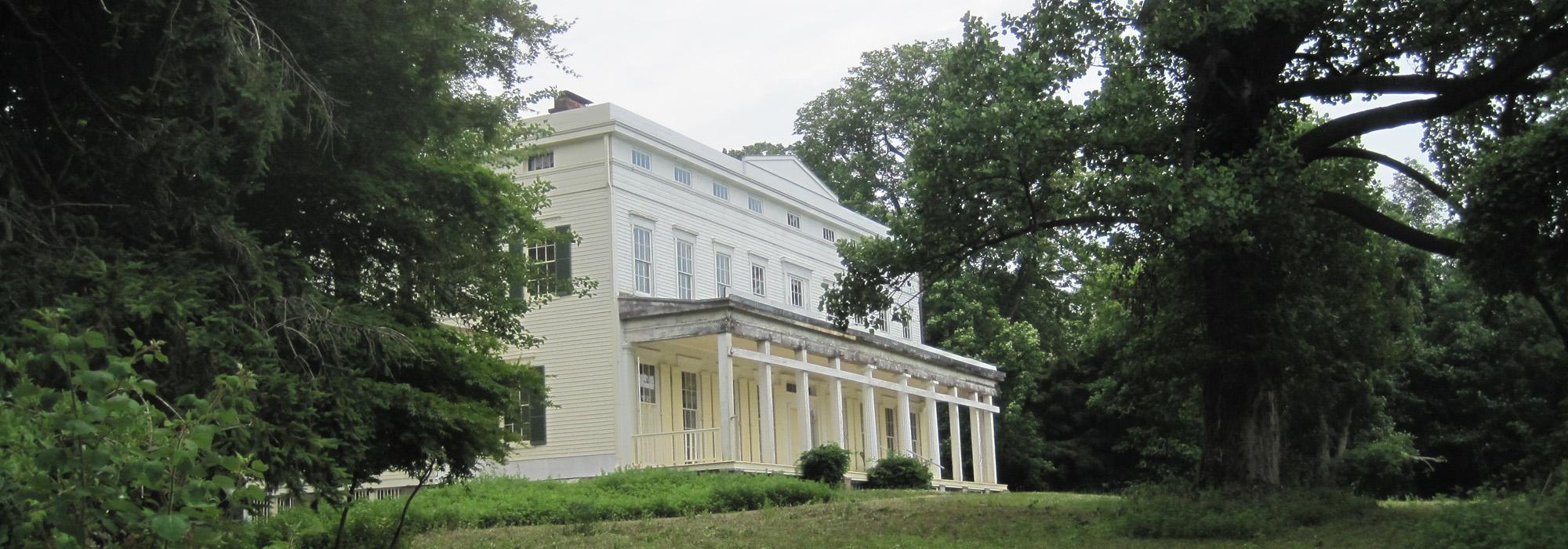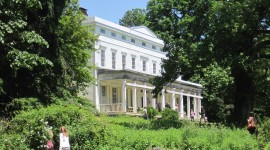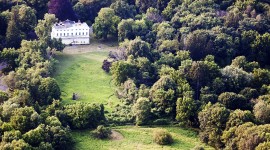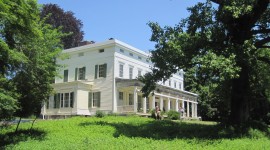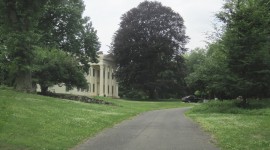The Jay Estate Threatened by Erasure
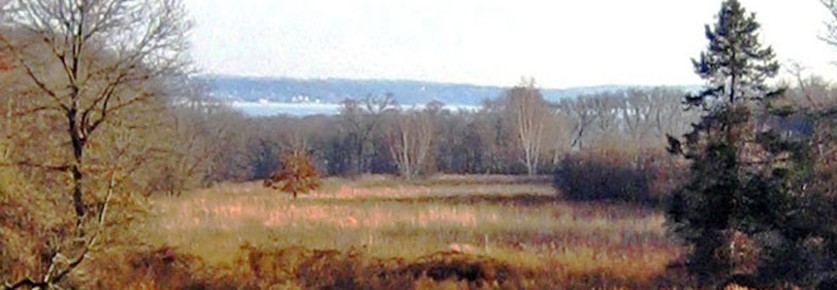
John Jay, one of the seven Founding Fathers of our nation, grew up in Rye, New York, on a 250-acre farm known as “The Locusts.”
His father, Peter Jay, was a successful merchant and avid horticulturalist, renowned for his skill in cultivating and grafting trees. Under the family’s care, the ancestral Jay home grew to 400 acres that included well-tended pastures for livestock, bountiful gardens and orchards as well as a veritable arboretum of trees including elms, oaks, and horse chestnuts. This is the green crucible that shaped the character of the architect of the Treaty of Paris that ended the Revolutionary War; the first Chief Justice of the United States; a beloved New York State Governor; and a leading abolitionist who helped end slavery in New York.
Today, despite a wealth of supporting documentation, and years of fundraising, research, planning and restoration efforts to the property’s principal structure by the non-profit Jay Heritage Center, the National Historic Landmark landscape has deteriorated dramatically with the proliferation of invasive plants and deliberate lack of maintenance aimed at erasing significant traces of its historic design intent.
History
In 1745, Peter Jay, a successful merchant and avid horticulturalist renowned for his skill in cultivating and grafting trees, purchased 250 acres in Rye, New York, with the hopes that a move to the country would safeguard the lives and health of his family from a recent outbreak of small pox in Manhattan. “The Locusts,” as the estate was later known, was bounded by the Kings Highway (Route 1) and the Long Island Sound and became the family home and life-long retreat of John Jay, one of the seven Founding Fathers of our nation.

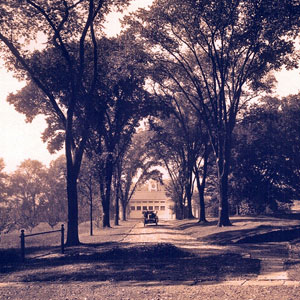
(top) Aerial view showing the open meadow, with the house at the top and the Sound at the bottom. (bottom) The elm allée.As a member of England’s Royal Horticultural Society, John Jay eagerly shared his passion for planting trees with his American colleagues and his children, regularly sending them seeds from his travels in Europe. Long before he inherited the property outright, John Jay treated it like his own, maintaining gardens, planting trees, and establishing, in 1807, a tranquil cemetery lined with cypresses for himself, his siblings, and descendants. Together with his son Peter Augustus Jay, he oversaw the installation of gardens and elm tree plantings in Rye. He guided his son’s introduction of stone ha-ha walls in 1822 as a means to frame not only the landscape, but specifically the wide open meadow that stretched to the water. The ha-ha walls served many functional as well as aesthetic purposes including: an uninterrupted view of the water from the mansion; a formalized Palladian vista of the estate from the Sound; a means to keep livestock from straying off the property; and a way to conceal an irrigation system that connected wells to fields and gardens throughout the property.
The most prominent feature of this landscape is an expansive meadow that is believed to be the oldest man-managed meadow on record in New York State. This magnificent swath of golden grass pre-dated his family’s residency by thousands of years, to Paleo-Indian times when the land was a fertile settlement site and regularly burned to renew growth. John Jay and generations of Jays, including the slaves they owned and emancipated, were themselves stewards of this landscape that had been mapped out by primitive human hands and tools. Like the Siwanoys before them, the Jays used controlled fires to rejuvenate their fields and maintain these same vistas of the horizon.
Upon this pre-existing, living framework, the Jays pursued a love of nature; they layered elm allées and gravel paths along site lines to visually and physically connect different parts of the estate. Under Peter Augustus’ aegis, the gentleman’s farm became a country estate, formalized even more so in 1838 when he demolished the old farmhouse and built a Greek Revival mansion on the same site. At this time, American estate design was heavily influenced by the styles of Alexander Jackson Davis and Andrew Jackson Downing who together designed many rural residences where architecture and landscape were wed in a newly romantic style. Peter Augustus embraced this movement as did his son John Clarkson Jay. In 1849 John engaged Davis to design and build a Carpenter Gothic boathouse on "Cherry Hill"- a vantage point where one could simultaneously take in the gardens, the meadow, and the water where sailing regattas were becoming more frequent. Family correspondence reveals there were also boxwood gardens and a series of ponds on the estate. Moreover, this Rye landscape and her family’s interest in horticulture was likely the inspiration behind Mary Rutherfurd Jay, John Jay’s great, great, granddaughter, becoming a landscape architect.
In 1905, the property was sold out of the Jay family to a wealthy Dutch financier, Warner La Montaigne van Norden. Cognizant of the stature of this waterfront parcel, Van Norden preserved and enhanced its man-made features with the help of local landscape architects. Open gardens and fields were formalized into garden rooms, all built along the existing axis to the water first established by the Jay family. A serious scientific interest in animal husbandry is evident in the creation of a Zebra House and outdoor kennels and paddocks. Like the Jays, he raised livestock that grazed in the fields behind the Jay mansion.
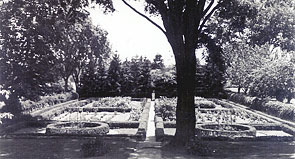
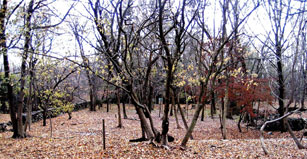
Garden rooms designed by Brinley & Holbrook are now filled with invasive plant materials that have shaded out historic and native plantings.
Princeton benefactor, Edgar Palmer, would subsequently purchase the estate in 1911 and, as archival drawings suggest, retain the landscape firm of Brinley & Holbrook who were working contemporaneously on Rye Town Park. With the firm’s guidance, Palmer expanded the grounds to create a family compound that included homes for his wife’s sister and brother along with newer recreational facilities like an indoor tennis court.
Private ownership and careful stewardship of the Jay Estate ended in 1979 when a local developer threatened to build more than thirty condominiums on the property. During the course of litigation and a thirteen-year-long grassroots effort to save the antebellum landscape and its buildings, specimen trees were removed, unclean fill materials were brought in, and invasive plants flourished, nearly making the property unsafe. The Jay Property was eventually rescued by a coalition of 62 historic and environmental organizations. These advocates persuaded Westchester County and New York State to take action to purchase and thereby protect the Jay Property in perpetuity.
The goal of the Jay Heritage Center is restoration of the 23-acre Jay Property as a cohesive whole that tells the story not just of John Jay and his family but of all the residents and stewards of the Jay Property, before and after the creation of our country. The significance of the Jay Property has been repeatedly recognized, including its addition to the National Register of Historic Places in 1982 and its designation as a National Historic Landmark in 1993 because of its importance in interpreting the birth of our nation and the evolution of our cultural heritage. In 2004, the site was added to Westchester County’s African American Heritage Trail and, in 2009, unanimously voted into the Hudson River Valley National Heritage Area list for its green management practices.
Threat
Today, despite this obvious wealth of supporting documentation provided by Jay, Van Norden and Palmer descendants, and years of fundraising and research efforts by the non-profit Jay Heritage Center, the Jay Property has deteriorated dramatically. The ¾ mile long meadow and viewshed to the Sound that men and women toiled for 10,000 years to keep open, a landscape that sustained and nourished native New York flora and wildlife for centuries, is now vanishing through neglect and sanctioned growth of invasive plants by local and state government officials who have ignored the historic importance of the National Historic Landmark property and whose management philosophy has been “to let nature take its course.”
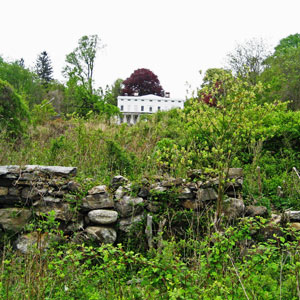
Southern ha-ha wall, overgrown and crumbling.
The invasive plant materials, including multiflora roses and Norway maples, are taking hold, thus destroying not only historic visual and spatial relationships, but are also compromising the lifespan of already aged and stressed mature canopy trees. This unmonitored deferred maintenance, has resulted in the death or damage of countless specimen trees and native plants that have been subsumed by vines and disease. In addition, inappropriate modern features have been added to the grounds without thought to period compatibility or accuracy. Ha-ha walls have been allowed to crumble and vandals have removed significant elements and artifacts. Wooden gates that might have been preserved through intervention have rotted in place. Most recently, encouraged by the lack of oversight and security, active dumping of construction debris and contaminated fill threatens the integrity of the site as well as the health and welfare of people, wildlife, and watershed.
Without rapid intervention and adherence to appropriate preservation standards and guidelines established by the Department of the Interior, the living and non-living character-defining features and materials will be lost forever. The Jay Property, as the oldest man-managed landscape in New York State and one of the oldest in the country, will cease to be recognizable and the adverse affect will be irreversible.
After decades of unsuccessful appeals by the Jay Heritage Center and its supporters, including many of John Jay’ descendants, to halt destructive maintenance and management practices at the Jay Property, the Jay Heritage Center (JHC) filed a Notice of Claim against Westchester County in May 2010. JHC demanded that the County correct the extensive damage it has caused in the past 18 years. This year, JHC appealed to the New York Department of Environmental Conservation who positively confirmed that Westchester County had violated the law by dumping contaminants and debris on the site. By visibly abandoning and vandalizing the Jay Property, the County has violated its own Legislation and created both a dangerous public and private nuisance for the public. The Board of the JHC is committed to seeing these practices that degrade the character and the ecology of the Jay Property stopped once and for all.
Get Involved
In 2004, the firm of Heritage Landscapes created a comprehensive Cultural Landscape Report detailing the known history of the Jay Property and making treatment recommendations for this National Historic Landmark as a vibrant educational center. The Jay Heritage Center strongly believes that the implementation and funding of this award winning plan will permit both experienced volunteers and enthusiasts to help preserve the site properly. Volunteers will be able to participate in a range of activities, depending on their interests, from hands on replanting of the historic gardens or elm allées to maintenance to fundraising. If you or your organization would like to contribute resources to maintain the grounds or contribute directly to restoration of the landscape, please contact the Jay Heritage Center at (914) 698-9275.
Moreover, letters advocating the use of the Cultural Landscape Report as the guiding instrument for revitalization of the Jay Property can be mailed to The Jay Heritage Center, 210 Boston Post Road, Rye, NY 10580 or e-mailed to jayhc@earthlink.net; they will be forwarded to our local, New York State, and Federal representatives.
All images courtesy the Jay Heritage Center.



